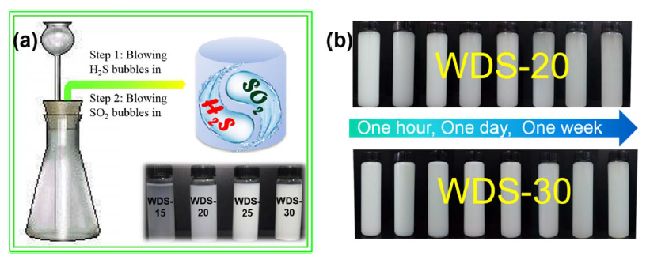Dominant pollutants of smog like sulfur containing gases may cause serious health problems, while researchers use them to produce water-dispersed sulfur nanoparticles for lithium-sulfur (Li-S) batteries.
Professor Quan-Hong Yang, the winner of the National Science Fund for Distinguished Young Scholars from Tianjin University, together with his research group, confined the gaseous H2S + SO2 reaction in water and successfully achieved “green” manufacture of water-dispersed sulfur nanoparticle (WDS). The WDS acting as an electrode material and an interlayer can efficiently improve the performance of Li-S batteries in electric vehicles.
This idea of turning pollutants into clean energy is a combination of air pollution control and new energy storage devices development. The research results have been published in the latest Nano Energy(2017, 41, 665-673), a prestigious international journal in the field of nanoscience and energy applications.

Fig. 1. Schematic of the synthesis of WDS. (a) Schematic of the synthesis of WDS with the inset image showing the different colors of WDS-15, WDS-20, WDS-25 and WDS-30. Water is the medium for the reaction and for the dispersion of WDS, so the formation dynamics of WDS can be well controlled, resulting in different WDS samples. (b) Pictures of WDS-20 and WDS-30 after a series of standing experiments, showing their excellent dispersion stability.
The Li-S battery with ultra-high energy density is one of the major directions for the future development of electric vehicles. As its cathode active material, sulfur shoulders the burden of energy storage. Breaking the limitations of traditional disposal methods,it is a great innovation in the marriage of pollutant control and new energy storage technology to convert waste sulfur into active material applicable to Li-S batteries in a highly efficient way.
According to professor Yang, the research group has been trying to turn air pollutants into something key to new energy storage devices since 2013. Recently, experiments show that H?S and SO? gases can play a certain role of “power bar” in Li-S battery. Inspired by basic chemical reactions, researchers accomplished the redox reactions of H?S and SO? with water as the reaction medium. This is a totally “green” method that produces only water-dispersed sulfur nanoparticles and water.
Professor Lu Jun, a famous battery expert from Argonne National Laboratory in America, pointed out that this groundbreaking conception was very ingenious to kill two birds with one stone. The sulfur nanoparticles would greatly promote Li-S batteries’ improvement of performance and industrialization.
This news was also reported by China Daily. For more information, click the link:http://www.chinadaily.com.cn/edu/2017-11/02/content_34015959.htm.
By: Song Shuang
Editors: Yin Wei & Doris Harrington






